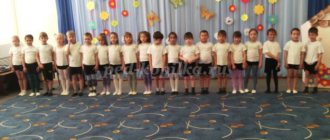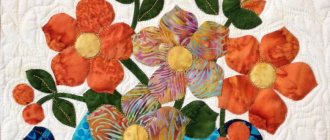Summary of drawing lesson “Household Appliances”
Goal: teach children to draw household appliances.
Software tasks:
- learn to draw rectangular objects;
- develop the ability to place an image on a sheet of paper, draw large;
- systematize children’s ideas about household appliances;
- promote safe handling of electrical appliances.
Methods and techniques: game motivation, artistic expression, questions, examination, instructions, demonstration, encouragement, reflection.
Equipment: character Cheburashka (adult), illustrations of televisions; album sheets, simple pencils, colored pencils.
Progress of the lesson
Creating gaming motivation
Educator: Guys, Cheburashka came to visit us today. Cheburashka: Hello! I really want to help my toy friends that you have in the group. My friends really want you to have a TV in your group because when you go home they get bored. And they really want to watch their favorite cartoons in the evening.
Educator: Guys, let's help Cheburashka and draw TVs for our toys? (Yes) The teacher reads a poem to the children: He shows us miracles in the evenings.
On his screen, friends, the seas are rustling in the fog, the fruits are shaking in the garden, there are programs for children.
Educator: What is a TV? (Children's answers)
A television is a special device for transmitting sound images over a distance. Probably, both adults and children love to watch TV shows. Where does the image on TV come from? The picture we see is created in television centers, turns into a signal, and is picked up by an antenna standing on the roof of the house. From the antenna, the signal travels through wires to the TV. (The teacher places illustrations on the board)
Educator: What needs to be done for the TV to start working? (Plug it in, take the remote control) - What do we call devices that operate using current? (Electrical appliances) - Remember what rules for handling electrical appliances, and specifically TV, we must follow?
Rules for using TV
- Do not touch the TV while it is running with wet hands.
- Do not touch faulty wires with your hands.
- Adults must turn the TV on and off.
- When leaving home, turn off the TV.
- You can't play near the TV.
Showing Picture Methods
Educator: We will draw the TV with a simple pencil. What shape is the TV? (rectangular) - Draw a large rectangle covering the entire sheet. Now you can depict your favorite TV show on the TV screen and color the image with colored pencils.
TV drawing
Finger gymnastics “I have toys”
I have toys: (clap their hands and bang their fists against each other) A steam locomotive and two horses, (bend the fingers on both hands) A silver plane, Three rockets, an all-terrain vehicle,
Dump truck, crane - A real giant. How many together? How to find out? (Clap their hands and hit each other with their fists alternately) Help me count!
Practical activities for children
Children draw a large rectangle with a simple pencil. Then they draw the image and color it. (If the children cannot draw an image on the TV screen, the teacher will complete the drawing herself, and the children will paint it in)
Physical school
Here is a big pyramid (Stretch up) And a cheerful ringing ball (Jumping in place) A soft bear with club feet (Steps in place, on the outside of the foot)
Everyone lives in a big box (Show a big square) But when I go to bed (Hands under my cheeks, close my eyes) Everyone starts playing (Image any movement)
Bottom line. Reflection
Educator: Cheburashka, look at what wonderful TVs the children have drawn for your friends. Cheburashka: Thank you, guys. I will give these TVs to my friends. Educator: Guys, for whom did you draw TVs? What are your favorite shows to draw?
Source
Calendar plan on the topic “Electrical appliances” for a week for a preschool educational institution
Topic: "Electrical appliances"
Monday.
Morning.
1. Conversation “Household appliances in human life.” GOAL: To cultivate a caring attitude towards household appliances. Note that household appliances did not always exist; they arose after the invention of electricity. To form ideas about household appliances widely used at home
2. Articulation gymnastics. Exercise "Painter". Tasks. To develop in children the ability to lift the tongue upward, develop its mobility, the ability to control it, and promote phonetically correct speech.
3. Didactic ball game “Say the other way around.” Tasks. Teach children to select antonym words, act as players, drivers and organizers of the game. Develop verbal imagination
4. Exercise: “It’s nice to look at a neat person!” Goal: to develop children’s ability to take care of their appearance. Discuss with the children what kind of person can be called neat, what he looks like, and how he behaves.
GCD 1. Speech therapy
2. H.E.R. Modeling "
Household appliances for little gnomes
»
Program tasks:
Expanding and deepening understanding of household appliances, their parts and purpose. Enrich children's understanding of the surrounding objective world. To strengthen children's understanding of objects that make human work easier. Fostering friendly relationships among children and a desire to help. To instill in children a respectful attitude towards work. To develop in children the ability to evaluate their own actions and the actions of their peers. To strengthen children's ability to describe this or that household appliance. Improve the development of fine motor skills of the arms and hands in children. Continue to reinforce in children the ability to use various methods of connecting parts when sculpting.
Vocabulary work:
clarify, expand and activate children’s vocabulary on the topic “Household Appliances”.
Material:
illustrations of household items (iron, refrigerator, stove, vacuum cleaner, etc.)
Plasticine sets, stacks, boards, hand wipes. Balloon with letter/Ball
Methodical techniques:
surprise moment - writing, reading a letter, motivation, conversation about household appliances and its parts, physical training, d/i “Which, which, which?”, reminder of sculpting methods, independent and ind. work, result.
3. H.E.R. Musical
Walk.
1. D./i. “It’s similar - it’s not similar.” Purpose: to teach children to compare objects; develop thinking.
2. P./i. "Owl." Goal: to develop inhibition and observation.
3. P./i. "From bump to bump." Goal: development of resourcefulness; ability to navigate in space.
4. Labor activity. Clearing the area and paths of snow and debris. Goal: to cultivate diligence and the desire to complete the work started.
5. Exercise to develop jumps. Goal: to strengthen the ability to jump on one leg.
2nd floor day
1. Reading the fairy tale by E. Nefedova “The Tale of How Electrical Appliances in a Store Quarreled.” Goal: to develop interest in fiction, the ability to answer questions about the content.
2. Didactic exercise “Come up with it and name it.” Goal: to exercise the ability to come up with words for a given sound.
3. D/i. “Which one, which one, which one?” Purpose: to practice selecting quality adjectives.
4. Game situation using the Lego constructor on the topic: “Kitchen for a doll.” Goal: To develop the ability to create technical items from a Lego set. Develop logical thinking and constructive abilities.
Walk.
1. P./i. "Ocean is shaking". Goal: to develop imagination, the ability to express a conceived image in movement.
2. Independent play activity.
3. Situational conversation “Safety rules while walking.” Goal: to instill caution in children, the ability to choose safe objects for play.
Tuesday.
Morning.
1. Ind. work - game "What is this for." Objectives: to strengthen the ability to select verbs and compose complex sentences.
2. Conversation “Our helpers are electrical appliances.” Objectives: to summarize children’s knowledge about household electrical appliances, their purpose and rules of use, to instill in children a sense of careful handling of electrical appliances, to develop mental activity and curiosity.
3. Asking riddles “Guess the electrical device.” Objectives: to develop imagination, the ability to generalize, enrich children’s vocabulary and encourage them to use complete sentences in speech, continue to teach children to guess.
4. Children’s independent play activities: looking at the album “The World Around Us.” Objectives: generalize children’s knowledge about household electrical appliances, their names and rules of use.
GCD 1. Speech therapy
2. P.R. FEMP "
Preparation and solution of problems
»
Program tasks:
Learn to compose arithmetic problems involving addition. Strengthen the ability to name the days of the week. Strengthen the ability to see geometric shapes in surrounding objects. Develop attention, memory, logical thinking.
Vocabulary work:
condition, question, solution, answer.
Material:
Vase, 4 flags, 3 cubes, squares of two colors, 5 triangles of the same color, pictures with schematic images of children in different poses, 5 sheets of whatman paper with images of geometric shapes (circle, square, rectangle, triangle, oval), a picture of cats, located in 3 rows. Triangles of two colors, cards with pictures of cats, pencils.
Methodical techniques:
org. moment “Days of the week”, compiling and solving addition problems, consolidating parts of the problem, physical exercises using diagrams, d/i “Complete the object”, “Finish the row”, work in notebooks, summary.
3. F.R. Physical education No. 31
II
half.
day H.E.R. Drawing " Household Appliances
"
Program tasks:
To consolidate children's ideas about household appliances and their purpose. Teach children to depict various household appliances by composing images from geometric shapes. Learn to convey in a drawing not only the form, but also the mood, the character of the “revived” devices. By adding various details and small elements, ensure that what is depicted matches the intended image. Improve compositional skills, drawing techniques with colored pencils, and color perception. Develop accuracy, the ability to complete work, and the ability to listen to peers and adults.
Vocabulary work:
electrical appliances, electrical equipment, mobile phone, landline phone, refrigerator, tape recorder, washing machine, vacuum cleaner, TV, iron, stove, hair dryer, mixer, light bulb.
Material:
colored crayons, felt-tip pens, pencils, album sheet.
Methodical techniques:
ball game “One-many”, riddle, partial demonstration of a sample; game “Connect the dots”, “Draw the same as mine”; gymnastics for fingers, questions from the teacher, results, exhibition of works
Walk
1. Observation: behind the clouds. Objectives: to continue to form the consciousness of the unity of earth and sky as the basis for a holistic perception of the world.
2. Ind. work - game exercise “Tracks”. Objectives: practice the ability to run after each other, making difficult turns, maintaining balance, not interfering with each other and not pushing the person running in front.
3. P/n “Get to your places quickly.” Objectives: continue to develop dexterity, the ability to act on a signal, increase interest in the game
4. P/n “Freeze.” Objectives: to develop children’s ability to understand a schematic representation of a person’s pose.
5. Independent play activities of children: according to the interests of children. Objectives: to develop children’s independence, activity, and to develop the ability to spend their leisure time interestingly and usefully.
II half day
1. Ind. work - game "What is it made of." Objectives: to develop the ability to form relative adjectives.
2. Reading an excerpt from B. Zhitkov’s work “What did I see?” Objectives: to expand and consolidate children’s knowledge about the everyday work of an electrician, to arouse interest in gaining knowledge through games.
3. Playing out dangerous situations “Child alone at home with electrical appliances.” Objectives: to warn children from troubles associated with household appliances, to develop caution and caution in children.
4. Independent play activities for children: in the library: looking at books on this topic. Objectives: to create conditions for viewing illustrations at will, to encourage children to tell stories based on the illustrations about the characters, their mood, feelings, actions, surroundings, and color scheme.
Walk
1. Observation: snow. Objectives: to develop children’s ability to observe seasonal changes in nature, to consolidate knowledge about the relationships occurring in inanimate nature (sun - snow).
2. Ind. work – game exercise “Inserting the ball”. Objectives: to develop the skill of dribbling the ball.
3. P/i “Move your purchases.” Objectives: continue to develop hand motor skills, dexterity, the ability to quickly complete a task, and act together.
Wednesday.
Morning.
1. Ind. work - game "Count to 5". Objectives: to develop the ability to coordinate nouns with numerals in gender, number, and case.
2. Conversations on the series of paintings “If you are at home alone” with a subgroup of children. Objectives: to develop in children the ability to foresee the consequences of their actions and unsafe entertainment, to develop speech and logical thinking.
3. Game “Complete the pictures” with a subgroup of children. Objectives: to develop visual attention, perception and fine motor skills of the hands.
4. Children’s independent play activities: looking at illustrations about the rules of safe behavior at home. Objectives: to strengthen children’s understanding of the rules of safe behavior at home in various situations
GCD 1. Speech therapy
2. S.K.R. LIFE SAFETY FUNDAMENTALS "
Magic electricity
."
Software tasks:
developing safe behavior skills when handling electrical appliances, generalizing children’s knowledge about electrical appliances and their purpose in everyday life;
introduce the concepts of “electricity”, “electric current”; introduce the rules for safe handling of electrical appliances. develop the ability to work with models;
develop the desire for search and cognitive activity; develop mental activity, curiosity, the ability to draw conclusions, cultivate interest in understanding the world around us; evoke the joy of discovery gained from experience.
Vocabulary work:
electricity, electric current, power plant.
Material:
d/i “Collect a picture”, a picture of a power plant, tables of safe behavior with electrical appliances.
Methodical techniques:
org. moment - poem, d/i “Collect a picture”, “What is this for?”, “What is, what was?”, physical exercise, teacher’s story “Where does electricity come from”, familiarization with the rules, experience with static electricity, summary.
3. H.E.R. Musical
Walk.
1. Target walk: around the territory of the kindergarten. Objectives: to introduce children to the characteristic signs of spring, to find them independently, to clarify ideas about the changes that occur in spring in the life of plants.
2. Ind. work - game exercise “Don’t touch me.” Objectives: practice walking like a snake between pins, improve balance.
3. P/n “Freeze.” Objectives: continue to develop children’s ability to understand a schematic representation of a person’s pose.
4. P/i “Entertainers”. Objectives: develop the ability to perform characteristic movements according to the content of the game, develop dexterity and speed.
5. Independent play activity of children: d/i “Count - don’t be mistaken!” Objectives: continue to practice forward and backward counting, reproduce the order of natural numbers in games.
2nd floor day
1. Ind. work – exercise “Assemble a sentence”. Objectives: to develop the ability to correct a deformed phrase.
2. Situational conversation “Electrical appliance dispute” with a group of children. Objectives: to develop children’s skills to prove that every electrical appliance is the most important in the house.
3. Reading and discussion of L. Panteleev’s story “The Big Wash.” Objectives: to develop artistic perception and aesthetic taste, to develop literary.
4. Independent play activities for children: games with Lego constructors. Objectives: develop imagination, design abilities.
Walk
1. Observation: tit. Objectives: continue observing birds, consolidate the names of body parts, nutrition, remember what wintering and migratory birds eat.
2. Ind. work - game exercise “Who will jump further (higher)?” Objectives: to train children in standing long jumps and running high jumps.
3. P/n “We are funny guys.” Objectives: continue to develop the ability to act on a signal, exercise children in running, develop attention, coordination of movements, agility and endurance.
4. Independent play activity for children: an exercise to develop fine motor skills “Crumble bread for the birds.” Objectives: develop fine motor skills, cultivate compassion, empathy and the desire to care for others.
Thursday
Morning.
1. Ind. work - game “Guess the words”. Objectives: practice the formation of complex words.
2. Conversation “Past and present of home helpers” with a subgroup of children. Objectives: to give an idea of what household appliances used to be like.
3. Comparative listening to the works of P. I. Tchaikovsky with the play “The Lark” by M. I. Glinka with a group of children. Objectives: invite children to express their impressions of the piece they listened to and display the mood in motion.
4. Children’s independent play activities: looking at illustrations depicting original interior design solutions. Objectives: strengthen perspective and composition skills, develop the ability to depict an interior.
GCD 1. Speech therapy
2. P.R. FEMP "
Parts of the day
»
Program tasks:
continue to learn how to compose and solve arithmetic problems involving addition and subtraction. consolidate the ability to navigate the parts of the day. Improve your ability to navigate on a sheet of squared paper. Develop attention, memory, logical thinking.
Vocabulary work:
day, day, night, morning, evening.
Material:
Cards with numbers, 4 cardboard models of coins, a picture of a labyrinth, sets of red and yellow circles, checkered notebooks with a sample drawing, symbols of the parts of the day, pictures of labyrinths, colored pencils.
Methodical techniques:
org. moment d/i “Right-Left”, drawing up and solving problems, work in notebooks, d/i “Parts of the Day”, “Piglets and the Gray Wolf”.
3. H.E.R. Drawing "
My favorite cartoon
»
Programming tasks:
Teach children to figuratively reflect impressions of life around them in drawings. Continue to teach independently, outline the content of the work and select the color of the pencil, develop creative taste and imagination; cultivate accuracy and perseverance; strengthen children’s ability to answer questions in complete sentences, cultivate a respectful attitude towards people of this profession, and develop fine motor skills.
Material:
album sheet in the form of a TV, sample, su-jok, paints, brushes, crayons.
Activating the dictionary:
electrical appliances, electrical equipment, mobile phone, landline phone, refrigerator, tape recorder, washing machine, vacuum cleaner, TV, iron, stove, hair dryer, mixer, light bulb.
Methods and techniques:
ball game “One-many”, riddle, partial demonstration of a sample; game “Connect the dots”, “Draw the same as mine”; gymnastics for fingers, questions from the teacher, results, exhibition of works. Health-saving technologies: finger gymnastics (Su-jok balls)
Physical education in games on a walk No. 16
Walk
1. Observation: of the driver’s work. Objectives: to clarify the idea that every driver must carefully monitor moving vehicles, traffic lights, and road signs.
2. Ind. work – game exercise “One, two, three, run to the refrigerator.” Objectives: practice running, completing a task to improve the ability to navigate in space.
3. P/i "Entertainers". Objectives: continue to develop the ability to perform characteristic movements according to the content of the game, develop dexterity and speed.
4. P/i “Five Steps”. Objectives: to cultivate intelligence and quick thinking
5. Independent play activity of children: sports game “Band Hockey”. Objectives: develop the ability to make passes to a playing partner.
II half day
1. Ind. work - game "Giant and Dwarf". Objectives: practice forming words using diminutive suffixes.
2. An evening of riddles and stories about electrical appliances with a group of children. Objectives: develop children’s skills in solving riddles about household appliances, improve speech.
3. Reading the poem by Yu. Sklyarova “Electrical Appliances.” Objectives: generalize and expand children’s knowledge about household electrical appliances, deepen interest in fiction.
4. D/i “Chain of words”. Objectives: to train children in identifying the first and last sounds in words.
5. Independent play activities for children: in the theater corner. Objectives: to develop children's independence, initiative, and creative abilities.
Walk.
1. Observation: weather. Objectives: to strengthen children’s ability to independently determine the weather, name its main characteristics: cloudiness, temperature, precipitation, wind.
2. Ind. work with boys - game exercise “Who’s ahead?” Objectives: exercise the ability to run in a column, one at a time, at an average pace.
3. P/i “Birds are flying.” Objectives: continue to develop children’s skills in jumping from low objects, running in all directions, acting on a signal
4. P/i “Hot light bulb”. Objectives: secure the ball passing in a circle.
5. Independent play activity for children: “Run up and catch” with the ball. Objectives: develop agility and speed in order to catch the ball.
Friday
Morning.
1. Ind. Job. - game “Say the opposite”. Objectives: consolidate the ability to select antonyms.
2. D/i “What is where?” with a subgroup of children. Objectives: practice orientation in space
3. D/i “Long, wide” with a subgroup of children. Objectives: to consolidate the ability to compare the length and width of objects using a conventional measure.
4. D/i “Wonderful Bag”, topic “Household Appliances” with a group of children. Objectives: to improve children’s ability to recognize and correctly name electrical appliances and their characteristics to solve a game problem.
5. Independent play activities of children: in the corner of sensory education. Objectives: to consolidate children’s ability to perceive the various properties of objects using different senses, compare and classify them.
GCD 1. Speech therapy
2. H.E.R. Application "
Electrical Appliances
»
Program tasks:
consolidate the ability to cut and paste images of familiar objects; to convey on a plane the character and image of shop windows using the appliqué technique; measure the image with the size of the sheet, arrange the images beautifully on the sheet, develop the image, creativity, fine motor skills, cultivate aesthetic taste when selecting paper of matching colors to compose an image, teach children to accompany the actions performed with speech: cut out - spread with glue - apply - smooth with a cloth; learn to read simple sentences, expand your vocabulary, develop speech.
Material:
cardboard of different colors, colored paper, scissors, glue, pencils, felt-tip pens
Subject pictures depicting household appliances.
Vocabulary work:
on the topic "Electrical appliances"
Methodical techniques:
surprise moment - a letter from Cinderella, d/i “Continue the sentence”, display of samples, step-by-step demonstration of the method of action, physical training, practical part, help from the teacher, result.
3. P.R. Ecology «
Household electrical appliances
»
Program tasks:
expand children's knowledge about electrical appliances, their importance in human life, teach the rules of safe behavior with electrical household appliances. Warn against danger. Learn to act if necessary, learn to dial emergency numbers: fire service - 01; ambulance – 03; introduce the rules of first aid in case of electric shock or fire; promote a caring attitude towards one’s health and responsibility for one’s actions.
Material and equipment:
illustrations, subject pictures depicting electrical appliances, a telephone, a ball, green and red cardboard mugs, “electrical appliances” coloring book.
Vocabulary work:
plug, cord, socket, bare
Methodical techniques:
org. moment - riddles, d/i “Name it, don’t be mistaken”, conversation about the rules of using electrical appliances, d/i “Do’s and Don’ts”, physical exercise, d/i “What is this for?”, coloring of electrical appliances, summary.
II
half.
day F.R. Physical education No. 32 Walk
1. Observation: behind the drop. Objectives: to consolidate knowledge about changes in water depending on temperatures, to teach research activities.
2. Ind. work - game technique “Who will throw next?” Objectives: develop coordination of movements, the ability to impart force to a throw.
3. P/i “Five Steps”. Objectives: continue to develop quick wits and quick thinking.
4. P/n “Find yourself a partner.” Objectives: to improve children’s ability to act on a sound signal, orient themselves in space using color modules.
5. Independent play activity for children: d/i “Find a toy.” Objectives: to develop in children the ability to find an object, focusing on its main features.
II half day
1. Ind. work – d\i “One – many”. Objectives: develop the ability to form nouns. pl. parts in I. p. and R. p. (vacuum cleaner - vacuum cleaners - vacuum cleaners).
2. Experimental activity “Magic electricity”. Objectives: to generalize children’s knowledge about electricity, to introduce children to the cause of the occurrence and manifestation of static electricity, to cultivate interest in understanding the world around them, to arouse joy from discoveries gained from experiments.
3. S/r game “Helpers”. Objectives: invite children to role-play various situations and carry out role-playing interactions.
4. Independent play activity for children: coloring illustrations from coloring books. Objectives: to strengthen children’s skills in choosing the right color combinations.
Walk
1. Observation: of bushes on the site. Objectives: continue to introduce the shrubs of our area, develop the ability to compare them with other trees, and know about the peculiarities of the awakening of trees in the spring.
2. Ind. work - game exercise “Gymnastic balance beam”. Tasks: practice walking with side steps to the right and left along a log.
3. P/i “Hot light bulb”. Objectives: continue to reinforce the passing of the ball in a circle.
4. P/n “Don’t touch me.” Objectives: develop the ability to jump over a rope at a height of 15 - 20 cm.
5. Independent play activity for children: with a doll “Let’s roll the doll.” Objectives: to diversify the role-playing participation of children in playing with a doll, to help enrich the plot of children's games.
Abstract of GCD for drawing “Household Appliances”
Sofia Zemlyakova
Abstract of GCD for drawing “Household Appliances”
Educator Zemlyakova S.L.
• Learn to draw rectangular objects;
• Develop the ability to place an image on a sheet of paper, draw large ;
• Systematize children's ideas about household appliances ;
• Encourage safe handling of electrical appliances .
Equipment: Pinocchio character, illustrations of televisions; album sheets, colored pencils, simple pencils.
"Photographer"
Didactic task:
stimulate visual memory, clarify the names of household appliances.
Material:
household appliances or their image (10-15 pcs.), screen.
Exercise. An adult shows a set of objects, asks the children to name them, then summarize them in one word. Then he hides all the objects and asks him to name them all again.
As they are named, objects are taken out from behind the screen so that the child does not repeat himself. The one who can name all the objects at once wins.
"Listen and Draw"
Target:
teach children to communicate freely while making a joint drawing.
Material:
paper, felt-tip pens (pencils).
Game actions:
reflect in the drawing the understanding of a polysemantic word.
Progress of the game
The teacher names a word, for example “pen”, which has several meanings. The players’ task is to draw this word in all its diversity.
While working, children should be able to comment on their drawings and communicate freely.
Drawing objects with the word “leg” (on another sheet of paper) is done in a similar way.
"Finish the sentence"
Target:
activate words denoting household appliances; develop coherent speech; exercise in establishing cause-and-effect and spatio-temporal relationships.
Complete the sentence with pictures:
I'm cleaning the carpet... (with a vacuum cleaner). I wash clothes in... I listen to the news on...
I'm ironing... I'm watching a movie... I'm looking for new information in...
I whip cream with... I store food in... I sew a dress with...
I'm talking to a friend on... I'm taking a picture of our family...
Summary of the lesson "Electrical appliances" in the middle group
Olga Yanshina
Summary of the lesson “Electrical Appliances” in the middle group
Goal: To summarize children’s knowledge about household electrical appliances , their purpose and rules of use. Develop mental activity and curiosity. To instill in children a sense of careful handling of electrical appliances . Cultivate attention, sensitivity, responsiveness. Enrich vocabulary, develop coherent speech. Foster frugality and save energy, water, light, protect nature, etc.
Equipment, tools and materials: Cards with images of electrical appliances , riddles, illustrations “Rules for using electrical appliances ”
, fairy-tale character Simka.
On the topic: methodological developments, presentations and notes
develop the ability to answer questions, solve riddles; clarify knowledge about various types of household appliances; learn to be creative when working with plasticine.
Life safety lesson for older children.
Goal: To summarize children’s knowledge about household electrical appliances, their purpose and rules of use.
Robotics project.
The article indicates GCD with children of primary preschool age on electrical safety, preliminary work with children. Introducing parents how to introduce children to home helpers.
Summary of GCD in the senior group.
Thematic week in the junior group on home safety rules.
Source






